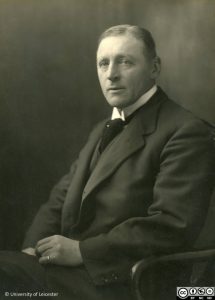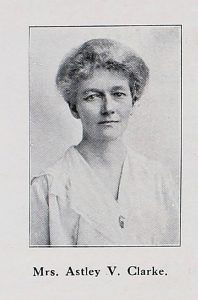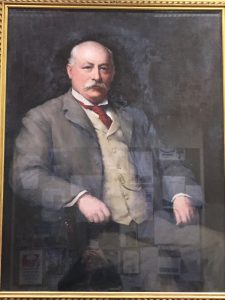In collaboration with colleagues from our Development and Alumni Relations Office, Archives and Special Collections recently contributed to an event welcoming to campus the descendants of some of our founding benefactors. I had the pleasure of meeting a group of visitors descended from Astley Clarke (1870-1945) and Harry Simpson Gee (1842-1924). The following is the text of the talk given to the families in recognition of the contribution of their ancestors to founding the University of Leicester.
Leicester, Leicestershire and Rutland College – now the University of Leicester – first opened its doors in 1921 having been conceived as a memorial to those who served in the Great War. It was intended to both honour the memories of those who had been killed, and give thanks for the contributions of all those who served and survived. This is reflected in the University’s motto, Ut Vitam Habeant, meaning ‘so that they may have life’, chosen by our first Principal Dr R. F. Rattray.
The idea of creating a University College for Leicester and the region had been discussed within Leicester’s Literary and Philosophical Society as early as 1880. When Dr Astley Clarke, a prominent local physician became President of the Society in 1912, he championed the idea once more, along with other notable members of the community. In his Presidential address he made the case with his characteristic passion and clarity:
I look forward to the time when Leicester will not be content without some University College or University in its midst, where the various branches of knowledge will have a fitting home, and the Institution be a part of Leicester’s daily life. I hope I may live to see, in my own branch of science, the opportunity of study of disease and its prevention, which now here are largely wasted, being fully utilised as a teaching centre for future guardians of the public and private health. [ULA/D2/2/1, Transactions of the Leicester Literary and Philosophical Society, 17 (1913)]
In 1917, there was already discussion across the county about war memorials to commemorate the losses and sacrifices of the war. A watershed moment came on 14 November, when the Leicester Daily Post, edited by W. G. Gibbs (our first secretary), published a leader article almost certainly written by Gibbs. It called for a ‘more than a mere artistic war memorial’ but ‘something of practical utility, yet ministering to the highest which is in us’. He proposed a University College, to be located on the site of the old County Lunatic Asylum which, during the war, had been in use as a military hospital for wounded servicemen:
On grounds of sentiment, as of imperative educational need, we, therefore, urge that borough and county authorities should lose no time in coming together and making arrangements by which this site may be definitely allocated to the erection of a University College, worthy memorial of the honoured dead of borough and shire, and a source of lasting benefit to present and future generations. [ULA/PCB1, p. 1. The full article can be read on our Special Collections Exhibitions website]
On 11 November 1918 – Armistice Day – Dr Clarke deposited the first £100 in philanthropic gifts for the endowment of a University College for Leicester, Leicestershire and Rutland. The gift is recorded in Astley’s notebook, now part of our archives, as:
A thank offering that he and his 2 brothers and sister (all of whom have done service in France) have lived to see the Victory of Right over might. [ULA/D2/1, Scrapbook on the foundation and early development of University College Leicester.]
Dr Clarke approached wealthy worsted spinner Thomas Fielding Johnson (whom he saw regularly in a professional capacity) to ask for help in founding the University College. Fielding Johnson had been thinking along exactly the same lines and had just paid approximately £40,000 (close to £2 million today) for land and buildings in Victoria Park which he planned to donate to the city for educational purposes.
These early gifts inspired a fundraising drive among local people. By 1920, the effort had raised £100,000, which was a huge sum for the time (equivalent to £4 million today). The University College opened in October 1921 with a small group of (mostly female) students, led by Principal Dr Robert Fleming Rattray. 15 students attended classes during the first year (compared with approaching 30,000 today). They were mainly drawn from the families of Leicester’s industrial and professional middle class, although one or two were from what would today be described as widening participation backgrounds. Among them was Nellie Bonsor, our first Students’ Union president and the daughter of a widowed laundress from Bull Head Street in Wigston. A young woman like Nellie would almost certainly have been unable to access a University education had it not been for the founding of the college a few miles away from her home.
Today provides us with an opportunity to express our gratitude to the families whose generosity and commitment to the cause of higher education created and sustained what would become the University of Leicester in 1957. Astley Clarke was a man of boundless energy whose contribution is hard to overstate. He galvanised support across the local community, and led the fundraising drive. He served on the College Council from the outset, acting as first vice-chairman and as chairman from 1938. Higher education institutions then, as now, were governed by committee and Astley sat on most of them, including the Finance Committee, Hostel Committee, Academic Committee, Laboratory Sub-Committee – even the 1928 Garden Party Sub-Committee. His contribution was strategic, intellectual and practical, extending as far as building book cases for use in the college library.
This sense of service and public duty was shared by Ethel (Poppy) Gee, Astley’s wife and daughter of Harry Simpson Gee. Poppy made a significant contribution to the life of the city, and served a range of local organisations, including as President of the Leicester branch of the National Council of Women. She was a member of the Belmont House Society for former pupils of Belmont House Girls School on New Walk. In 1921 the society staged a production of Laurence Housman’s Prunella to raise funds for the University College. Poppy’s contribution continued in her role as chair of the 1922 Bazaar Committee, which exceeded expectations raising £15,000 towards the college fund. As Caroline’s handout points out, this experience was not one that Poppy found entirely enjoyable, as her daughter later recalled:
My mother was terrified and had spent many sleepless nights . . . but once again she had underestimated her capabilities. [Information supplied by Caroline Wessell]
Poppy’s father, Harry Simpson Gee (1842-1924) played a pivotal role in the founding and early development of the college as Honorary Treasurer. Lamenting his passing in 1924, the college annual report expressed gratitude for the manner in which Simpson Gee had ‘placed his exceptional ability and experience in financial matters at the disposal of the College Council and its officer’. He made a significant posthumous contribution leaving £20,000 in his will for the creation of ‘The Simpson Gee Endowment Fund’. Gee was a well-known member of the local business community, as chairman of Stead and Simpson shoe manufacturers, founder of the Leicestershire Banking Co, and Director of the Midland Bank. As you’ll see from some of the cuttings we have on display, he was also a formidable personality. Reporting his death, the Leicester Mail stated that:
His bigness was always at the free disposal of young and struggling men of grit and character. Nothing gave him greater satisfaction than to advise and direct men whose character appealed to him, as many people in Leicester and elsewhere can testify. But woe be to the slacker and the trifler whom he came across. He never suffered fools gladly or sadly. He swept them from his presence without the slightest regard to their position or connections. [ULA/D2/1, f. 57v]
The Gee family connection to the University continued long after Simpson Gee’s death, through his four sons Ernest, Cecil, Percy and Charlie, as well as Poppy whom I’ve also mentioned. All gave generously to the University. Percy’s contributions included financial gifts of at least £30,000 and the bequest of his former home on Elms Road, which became Mary Gee Hall. He served as Chair of Council, Treasurer, and when he died the University’s annual report referred to him as, ‘for so many years [our] greatest benefactor and wisest councillor. There was indeed a period in the dark days of the College before the war when Percy Gee may be said to have carried it on his back’. [ULA/P/AR40B, University of Leicester Annual Report, 1961-62]
As part of the event, members of each family were given the opportunity to view material relating to their ancestors’ role in founding the University. Many of the items displayed were from the a scrapbook compiled by Astley Clarke, which can be viewed in full on Special Collections Online.
The contents of the talk draws on commissioned research funded by Leicestershire County Council’s Heritage Lottery Fund project, Century of Stories. I am grateful to Caroline Wessell for additional information supplied about her family members.





 Subscribe to Simon Dixon's posts
Subscribe to Simon Dixon's posts
Recent Comments